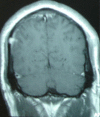Brain abscess and generalized seizure caused by halo pin intracranial penetration: case report and review of the literature
- PMID: 18751739
- PMCID: PMC2899570
- DOI: 10.1007/s00586-008-0759-x
Brain abscess and generalized seizure caused by halo pin intracranial penetration: case report and review of the literature
Abstract
The objective of our study is to report a rare complication of halo pin insertion associated with an epileptic seizure and brain abscess, and to discuss the diagnostic and therapeutic approach to its management. The treatment of unstable cervical spine injuries with a halo vest is an established procedure. Complications of pin penetration such as brain abscess and seizure are rare, and need to be urgently treated. Intracranial abscess and seizure associated with the use of the halo device is an unusual complication, and only a few cases have been reported in the literature. A 21-year-old male had a halo vest placed for the management of an odontoid type II fracture, which he sustained from a motor vehicle accident. Ten weeks after halo ring placement he complained of headaches which relieved by analgesics. After 2 weeks he was admitted at the emergency unit in an unconscious condition after a generalized tonic-clonic seizure. The halo pins were displaced during the seizure and were removed at his admission. No drainage was noted from the pin sites, and a Philadelphia cervical collar was applied. A brain CT and MRI revealed intracranial penetration of both posterior pins and a brain abscess in the right parietal lobe. Computed tomography of the cervical spine revealed stable fusion of the odontoid fracture. Cultures from the pin sites were negative; however, intravenous wide spectrum antibiotic treatment was administered to the patient immediately for 4 weeks followed by oral antibiotics for additional 2 weeks. Anti-epileptic medication was also started at his admission. The patient was discharged from the hospital in 6 weeks without symptoms, continuing anti-epileptic medication. On the follow-up visits he had fully recovered without any neurologic sequelae. In conclusion, complications of halo pin penetration are rare which need immediate intervention. Any neurologic or infectious, local or generalized, symptom need to be investigated urgently with available imaging techniques and treated promptly. Pin over-tightening may cause bone penetration and possible deep cranial infection with serious complications.
Figures




References
-
- Aderson LD, D’Alonzo RT. Fractures of the odontoid process of the axis. J Bone Joint Surg Am. 1974;56:1663–1674. - PubMed
-
- Clark C, White A. Fractures of the dens: a multicenter study. J Bone Joint Surg Am. 1985;67:1340–1348. - PubMed
-
- Garfin S, Botte M, Waters R. Complications in the use of halofixation device. J Bone Joint Surg Am. 1986;65:320–325. - PubMed
Publication types
MeSH terms
Substances
LinkOut - more resources
Full Text Sources
Medical

